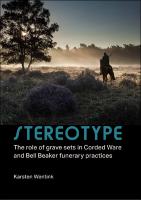Stereotype
The role of grave sets in Corded Ware and Bell Beaker funerary practices
Author(s)
Wentink, Karsten
Collection
Dutch Research Council (NWO)Language
EnglishAbstract
Throughout northern Europe, thousands of burial mounds were erected in the third millennium BCE. Starting in the Corded Ware culture, individual people were being buried underneath these mounds, often equipped with an almost rigid set of grave goods. This practice continued in the second half of the third millennium BCE with the start of the Bell Beaker phenomenon. In large parts of Europe, a ‘typical’ set of objects was placed in graves, known as the ‘Bell Beaker package’. This book focusses on the significance and meaning of these Late Neolithic graves. Why were people buried in a seemingly standardized manner, what did this signify and what does this reveal about these individuals, their role in society, their cultural identity and the people that buried them? By performing in-depth analyses of all the individual grave goods from Dutch graves, which includes use-wear analysis and experiments, the biography of grave goods is explored. How were they made, used and discarded? Subsequently the nature of these graves themselves are explored as contexts of deposition, and how these are part of a much wider ‘sacrificial landscape’. A novel and comprehensive interpretation is presented that shows how the objects from graves were connected with travel, drinking ceremonies and maintaining long-distance relationships.
Keywords
funerary archaeology; Bell Beaker culture; Corded Ware Culture; Late Neolithic; material culture studies; functional analysis; grave sets; social theory; identity; death; ritual; depositional practices; beaker; early metalworking; burial mounds; barrows; object biographies; categorization; presentation of self; usewearPublisher
Sidestone PressPublisher website
https://www.sidestone.com/Publication date and place
Leiden, 2020Imprint
Sidestone Press DissertationsClassification
Archaeology by period / region
Prehistory


 Download
Download Web Shop
Web Shop